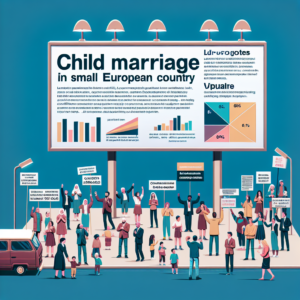#ChildMarriage #EndChildMarriage
Shattering the Shackles: The Crusade Against Child Marriage in Ecuador
Ecuador, a nation celebrated for its diversity, culture, and rich history in South America, is grappling with a grave challenge that jeopardizes the well-being of its younger citizens: child marriage. This practice, entrenched in tradition, poverty, and gender disparities, strips girls of their innocence and significantly undermines their access to education, health services, and economic growth. The campaign against child marriage in Ecuador is fundamentally a fight for human rights, aiming to liberate numerous young individuals from the constraints that limit their potential.
Deciphering Child Marriage
Child marriage refers to any formal marriage or informal union before reaching 18 years of age, affecting both boys and girls, though girls are disproportionately affected. UNICEF reports that Latin America and the Caribbean have the world’s second-highest child marriage rates, with Ecuador among the nations where this practice persists.
Underlying Causes
- Poverty: For many, marrying off daughters at a young age is a strategy to alleviate economic burdens, with dowries or “bride prices” providing financial relief.
- Tradition and Social Norms: Child marriage is a cultural practice deeply embedded in some communities, passed down through generations.
- Lack of Education: Limited access to education often leads families to undervalue the importance of schooling for their daughters.
- Gender Inequality: The perception of girls being less valuable than boys contributes to the prevalence of early marriages.
Detrimental Effects
Child marriage steals the innocence of girls, propelling them into a life filled with challenges. It frequently results in early pregnancies, a leading cause of mortality among girls aged 15 to 19 globally. Additionally, these girls face a higher risk of domestic violence and are less likely to continue their education, perpetuating poverty cycles.
Combating Child Marriage in Ecuador
In its efforts to combat child marriage, Ecuador has enacted laws setting the marriage age minimum at 18. Nevertheless, the enforcement of these laws remains lax, particularly in rural and indigenous areas where the practice is more widespread. The struggle against child marriage in Ecuador is multifaceted, encompassing legal reform, educational initiatives, and community involvement.
Legislative Efforts
By ratifying international agreements like the Convention on the Rights of the Child, Ecuador commits to protecting minors from early marriage. The nation has also implemented domestic legislation to raise the legal marriage age to 18. The challenge, however, lies in enforcing these laws across all regions.
Educational Initiatives
Education serves as a potent weapon in the battle against child marriage. Ensuring girls’ access to quality education empowers them to make informed choices about their futures and escape poverty. Various organizations and governmental bodies are striving to enhance educational opportunities for Ecuadorian girls.
Community Involvement
Altering deep-seated cultural norms necessitates active community engagement. Non-governmental organizations (NGOs) and activists are on the ground, working to shift perceptions of child marriage through awareness campaigns, workshops, and discussions with community leaders.
Agents of Change
The movement against child marriage in Ecuador gains momentum from the support of numerous influential figures, including renowned writers and human rights advocates. Their messages inspire and underscore the urgency of this cause.
- Malala Yousafzai, championing girls’ education, famously stated, “We cannot all succeed when half of us are held back,” emphasizing the critical role of education in empowering girls for a brighter collective future.
- Michelle Obama, in her advocacy for girls’ education, reminds us that a nation cannot thrive if it suppresses the potential of its women and neglects the contributions of half its population.
- Simone de Beauvoir, the French writer and philosopher, observed, “One is not born, but rather becomes, a woman,” highlighting the societal constructs of gender roles and the importance of challenging these norms for gender equality.
These influential voices reinforce the notion that the battle against child marriage transcends individual protection; it’s about fostering a just and equitable society for all.
Conclusion
The crusade against child marriage in Ecuador is a pivotal struggle within the broader fight for human rights. It demands a united front from governments, organizations, communities, and individuals. By elevating awareness, reforming laws, empowering girls through education, and challenging societal norms, we can dismantle the shackles of child marriage and unleash the potential of numerous young individuals. Echoing human rights activist Nada Al-Ahdal, “Protecting human rights is not an option, but a responsibility of us all” @nadalahdal. Let’s embrace this duty and strive for a world where every child can cherish their youth and aspire to a future filled with promise and opportunity.
#NadaFoundation
#ChildMarriage
#Nada_Foundation
#NadaAlahdal
#Breaking #Chains #Fight #Child #Marriage #Ecuador
breaking-the-chains-the-fight-against-child-marriage-in-ecuador






















